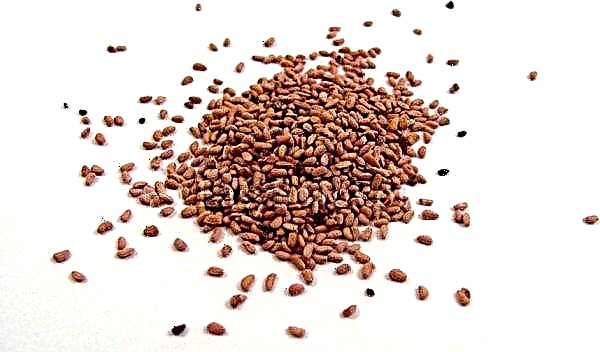The automatic ventilation system is an indispensable thing when growing agricultural crops in a greenhouse. There are many varieties of thermal drives that you can make yourself. More about this in our material.
Characteristics of an automatic greenhouse ventilation system
For crops grown in greenhouse conditions, it is necessary to maintain the ideal temperature and fresh air. In order to properly regulate the climate in the equipped garden, air vents with closers are installed.
- Airing allows you to:
- prevent the propagation of pests;
- maintain optimal temperature;
- control the humidity level in the room.
The thermal drive for greenhouses is presented in the form of a window leaf, equipped with automatic sensors that trigger when the temperature rises excessively in the middle of the greenhouse. Ventilation is installed in the ceiling of the structure, due to the property of the heated air mass rising up.
Important! Remember that the distribution of ventilation along the perimeter of the greenhouse should be uniform, which will ensure the same supply of fresh air, preventing draft. For a construction of 8 m in length, 4 air vents must be installed.
Advantages of using automatic ventilation systems
The advantages of an automatic ventilator can be considered with the Maksi thermal actuator as an example. The device demonstrates the reliability of holding the rod to 200 kg of pressure. A high degree of strength allows you to avoid unwanted damage caused by gusts of wind or attempts to manually close the installation site of the device.

The advantage of automatic ventilation of a modern sample is its compactness. The device is small in size, so you do not have to devote much space to its installation. Installation is carried out on a window or door leaf.
Climate control allows you to get rid of constant monitoring of temperature changes, freeing up time for the gardener to do other work in the greenhouse. An important advantage is the long period of use of the mechanism, the warranty is 10 years, and with proper operation, the period is significantly increased. In addition, during the entire period of use does not require additional adjustment. The device does not need an additional power source.
Types and principle of operation of automatic ventilation of greenhouses
To ventilate the greenhouse premises, an automatic thermal drive is used, the mechanism of functioning of which is to open and close the window, due to changes in air temperature.
Did you know? In countries with a cold climate, greenhouses are equipped in the form of extensions to the living room, which reduces the time for caring for plants and additionally heats the house.
There are several types of thermal drives:
- electronic;
- cast plate made of metal;
- hydraulic construction;
- pneumatic system.
Electronic thermal actuator
The electric drive is an efficient and convenient way to control the temperature in greenhouse conditions.
Electric drive components:
- a fan located in the upper part of the structure;
- thermal sensor.

The use of the electric drive is possible in greenhouses of any scale, thanks to a high degree of productivity. The process of action of the thermostat is the uninterrupted supply of electricity, which supports the operation of the device. Before installing the electric drive, you need to first worry about how to restore it to work if there is no electricity supply. The complete dependence of the device on the uninterrupted supply of electricity is its drawback.
The principle of operation of a plate made of different metals
In the ranking of the installation of automatic air regulators in a greenhouse, one of the last places is the bimetallic system, its working process is the physical ability of metals to react to changes in air temperature. The bimetallic system consists of two metal plates with different linear expansion indices. , and to close it - cool.
Important! Remember that with insufficient heating the bimetallic system will not work. In addition, it is difficult to find metals having the properties to expand at relatively low temperatures.
Features of the construction of hydraulics or pneumatics
Auto-greenhouse involves the use of a thermal actuator on a hydraulic and pneumatic basis. The process of the hydraulic system is the pressure of the fluid. The pneumatic system operates under air pressure. A hydraulic ventilator can be made independently.
Its components will be:
- a cylindrical body filled with liquid;
- the rod, which is set in motion due to the physical properties of the liquid that is charged into it.

The fluid should expand at + 23 ° C and push the stem with a force of 30 kg, while opening the window. If you do not know what to fill in the hydraulic thermostat, take the gear oil. As the rod moves backward, under its own mass, the system will take its original form.
The self-made design of a pneumatic temperature controller step by step is as follows:
- We take containers of 3 l and 1 l (you can use cans).
- Pour 0.8 liters of liquid into a 3-liter jar.
- We seal a large container with an iron cap and drill a hole for the tube, the end of which should not be in contact with the bottom of the can, the minimum distance should be 1 cm.
- We carry out similar manipulations with a smaller jar.
- Next, we connect the tanks with a plastic tube 1 m long.
- The resulting pneumohydraulic siphon is fixed from the inside of the room.
- In contrast to the empty jar of the obtained siphon, you need to attach a wooden beam from the outside.
- Above the window should be set emphasis.
The system works after an increase in temperature in a larger tank. The air mass pushes water into a smaller container, which drops down and opens a window. After lowering the temperature, the mechanism comes to its initial position and closes the window.
How and from what to make a thermal drive yourself
If there is a possibility and the necessary materials, then make a thermal drive yourself - this will allow you to get an autonomous system of thermal control indoors with minimal cost.
A vent for a greenhouse can be created with your own hands from the following materials:
- old computer chair;
- automobile shock absorber;
- automobile hydraulic cylinder;
- plastic container;
- balloon and rubber ball.
Video: Do-it-yourself automatic airing
From a computer chair
The lifting cylinder contained in the mechanism of the computer chair is able to become the basis of the thermal drive.
Did you know? The English government in 1734 obliged citizens to install ventilation systems powered by a steam engine in their homes, which contributed to their further development.
A step-by-step instruction for assembling a ventilator from a part of a computer chair is as follows:
- Dismantle the part, remove the plastic rod blocking the approach to the pin of the damper having a metal base.
- Clamp a rod with a diameter of 8 mm in a vice, insert a cylinder into it, thereby relieving it of internal pressure.
- Cut the lifting cylinder together with the taper with a grinder.
- Carefully remove the stem to avoid damaging the surface of the part and the rubber gasket on the cylinder.
- At the end of the stem, an M8 thread must be made. For this, the part is wrapped with two layers of tarpaulin and clamped in a vice.
- Replace the inner cylinder liner.
- Remove all rubber bands from the piston.
- Get rid of the metal shavings by wiping them with gasoline.
- To prevent the stem from falling into the cylinder under the action of the temperature controller, put a nut of size M8 on it.
- Insert the piston into the valve seat.
- On the cut side of the cylinder, weld a pipe section.
- Screw the extended M8 nut onto the stem thread, then screw the plug to connect to the window control knob.
- For the convenience of filling the tank with oil emulsion, put a plug on one side, and a faucet on the opposite.
- Remove air from the system and fill the structure with an oil emulsion.
From a car shock absorber
The following materials are used for the home-made design of the thermostat from a car shock absorber:

- gas lift;
- 50 mm steel pipe with thread on both sides (the height depends on the parameters of the greenhouse);
- fitting;
- coupling;
- ball valve;
- driving;
- sandpaper;
- epoxy resin.
Step-by-step instruction:
- We cut the bottom of the gas lift, make the edges bent so that the rod does not fall out. We cut holes of 2 mm in the tube.
- We clean all the details with sandpaper.
- We make a technical plug from the thread impregnated with epoxy resin. We put a fitting on the obtained plug.
- A piece of gas lift is inserted into the pipe, on the other hand we catch a valve with a drive. To make the connections more reliable, they should be fixed with gaskets.
- Open the cap and pour in the cooled emulsion.
- After completing the procedures, we fix the crane in the upper part of the window, and at the bottom we attach it to a wooden support in the form of a cross.

When the emulsion is heated in the tube, the shock absorber piston will open the window. After the liquid cools, the piston will fall into place and close the window.
From the hydraulic cylinder of a car
For a homemade ventilator from a hydraulic cylinder, you will need:
- gas cylinder;
- hose;
- M6 bolt;
- receiver.
Did you know? The main criterion when designing ventilation in any room is to take into account the amount of inhaled air by a person per hour.
The operation of the hydraulic cylinder occurs with the help of compressed gas. To make a thermal drive from a part, it is necessary to free it from the substance contained inside, for which it will be necessary to drill a small hole and bleed the gas. A 10 * 1.25 thread is knocked out in place of the hole, which will serve to further connect the hose. To fix the hinge in the same place, you will need an M6 bolt. The made receiver will displace air, after which it is possible to fill in oil. Be sure to ensure that the hydraulic cylinder rod is completely immersed in oil at low temperature. At the end of the work, it is necessary to check the device for leaks.
Using plastic bottles
The most economical home-made method of manufacturing a thermostat is the use of plastic water bottles in the work.

Materials for the manufacture of:
- plastic containers in the amount of 2 pieces of different volumes (5 l and 2 l);
- a connecting hose, the length of which is calculated from the bottle to the transom (with a surcharge);
- fitting;
- sealant.
Step-by-step instruction:
- A large bottle is poured with liquid to a third of the volume, a hole is made in the lid, the diameter of which is equal to the diameter of the taken hose.
- Insert the fitting into the connector and screw the hose.
- A bottle of 2 l is also filled with water by a third, screwed on with a lid, in which the connector for the second end of the hose is pre-cut.
- Process joints with sealant.
- A large bottle is installed at the bottom of the window frame, and a smaller bottle is placed at the top.
Did you know? The inhabitants of ancient Rome were the first to invent greenhouses. Gardeners planted the culture in carts, which were outdoors in the daylight under the sun, and at night they were left in a warm room.
This autonomous ventilation method using pneumatic control is suitable for a window that opens horizontally.
From balloons and a rubber ball
An original way to equip a greenhouse with a thermal drive is to make it from a balloon and an inflatable ball.
To make the device you will need:
- 2 metal cylinders;
- rubber ball;
- wooden box with a lid;
- timber;
- hose.
Step-by-step instruction:
- Attach the hose to the connecting cylinders. The height of the hose should be equal to the height of the greenhouse.
- The ball must be deflated and the second end of the hose attached to the nipple.
- The ball is placed in a box so that when it is inflated, the lid opens. A block is nailed to the box lid and connected to the window.
- Cylinders are fixed under the ceiling of the room, and the box with the ball is installed below.

When the balloons become hot under the influence of high temperature, the ball will fill with air and open the window. The reverse action will occur when the cylinders cool.
Features of mounting a thermal actuator in a greenhouse
When installing a thermal actuator, determine its location inside the greenhouse. Avoid places where direct sunlight can get on the device, otherwise it will work due to its own heating. Check the health of the window: it should open effortlessly. Try the thermal drive to the selected location for its further location. In any position of the window leaf, parts of the device must not come into contact with the frame.
Immediately before installation, the stem is completely retracted, for which they use exposure to cold. Keep the appliance in the refrigerator for some time. After reading the instructions, fasten the brackets for installing the thermal actuator, install the device.
The most advantageous arrangement of the device inside the greenhouse is the ceiling window. The advantage of the arrangement is the quick closing of the ventilation window under the pressure of the mass of the device, which will save the crops from overcooling. The mechanism should be placed in the ceiling window due to the fact that hot air tends to rise up. If there is a thermal drive in the upper part of the greenhouse, airing is faster. If the greenhouse has an air duct, you can use a ventilation grill, which is installed to receive fresh air and prevent dust particles from entering the room.
Using a thermal actuator in greenhouse conditions allows you to protect the grown seedlings from waterlogging and debate as a result of exposure to high temperature in the room. There are many ways to make an automatic ventilator yourself, which will save money and reduce the time spent in the greenhouse.












